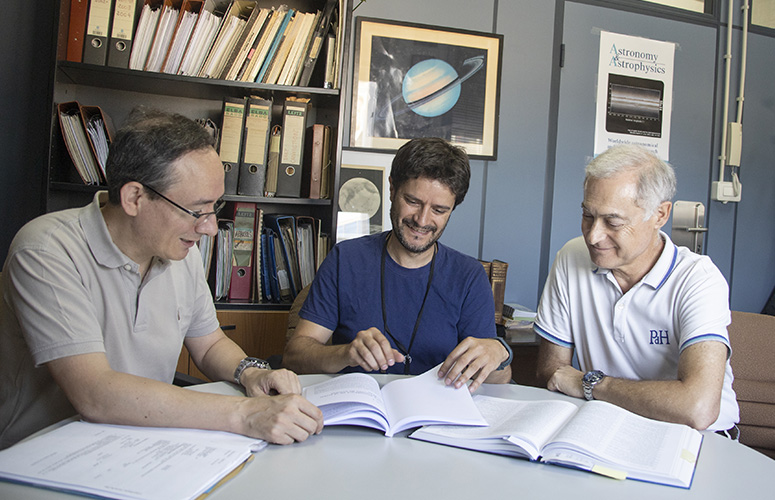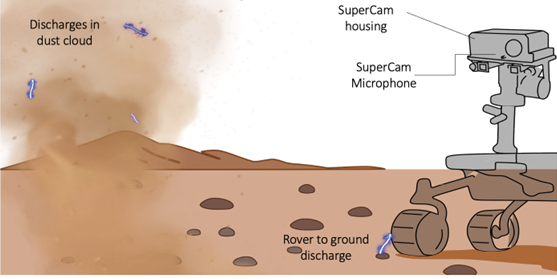UPV/EHU researchers have studied the weather on Mars using data from the weather station installed on the NASA Curiosity rover, an exploration vehicle located inside the Gale crater. This research has revealed important information for future Mars missions, has allowed dust storms in very distant regions to be detected, and hundreds of sand-carrying whirlwinds that are very numerous on the red planet’s surface have been detected and studied.
Dust storms on Mars spotted far away from the NASA Curiosity rover
The Planetary Sciences group of the UPV/EHU-University of the Basque Country is studying the surface atmosphere of Mars during the Mars Science Laboratory mission
- Research
First publication date: 06/08/2019

The UPV/EHU’s Planetary Sciences group, led by the astrophysicist Agustín Sánchez-Lavega, specialises in the study of the atmosphere of various planets in the Solar System. In a study of Mars’ surface atmosphere, one of the researchers in the group, Iñaki Ordóñez-Etxeberria, has handled data that allow the daily and seasonal meteorological variations to be studied; these include the passing of dust storms, local effects associated with the interaction of the atmosphere with the topography and transitory phenomena, such as the passing of convective whirlwinds known as dust devils capable of raising columns of dust from the surface. “Mars’ atmosphere is very thin, it is not as dense as that of the Earth, and that is why the daily temperature changes are more marked. Atmospheric pressure also changes during the day up to between 6 and 7 %, which is impossible on the Earth,” explained Ordóñez.
In the study they used data from the REMS weather station, one of the instruments on the NASA Curiosity Rover, located inside the Gale crater. The instrument was built by the Spanish Astrobiology Centre (Centro de Astrobiología-CAB) in Madrid. These data have been complemented "by orbital observations obtained by the MARCI camera on the MRO (Mars Reconnaissance Orbiter); they provide us with a complete image of the planet every day and enable us to see the dynamics of the dust clouds and storms on Mars”, explained Ordoñez. This has enabled them to check “how what we observed from space, the dust clouds and storms, affects the records we gather from the REMS weather station located inside a crater”.
Important, hitherto unknown information for future missions
Following laborious work to process the data gathered during the period between August 2012 and November 2016, the group have shown that the formation of dust storms in regions far away from the crater where the Curiosity rover is located, “even on the antipodes, causes a change in atmospheric pressure that is picked up by the weather station”. Ordoñez explained that “the dust storms are what most determines the weather on Mars”; they are tremendously violent, very extensive storms that generate highly significant wind strength. The researcher also pointed out that they have managed to measure meteorological parameters practically inside one of these local dust storms. “Until now it has never been achieved, but by coincidence a local storm was passing over our weather station and we were able to study numerous meteorological parameters, such as temperature and pressure variation,” he said.
Another of the highlights of this study are the dust devils. “Because the surface is heated by the sun, an air bubble is formed and rises, and this causes a kind of whirlwind a few tens of metres in diameter and with great strength; it is capable of functioning as if it were a vacuum cleaner and absorbs the dust present in the atmosphere.” By using the data from the weather station, they have been able in this research to count the number of events of this type that have taken place in the vicinity of the Curiosity rover, and have made a statistical study “to find out the times of day during which they are more intense and the period in which they are more frequent”, said Ordóñez. Using the data obtained by the research group, “these dust devils have been found to function like a vacuum cleaner because they suck the dust out of the atmosphere and clean the rover’s sensors”, he added.
This study will have a continuation in the short term “with the arrival of new space missions equipped with weather stations, such as Insight, which reached Mars at the end of 2018, and NASA’s Mars 2020, due to be sent next year. Mars 2020 will be fitted with the MEDA weather station, also built by CAB, and in which the UPV/EHU team is participating under the leadership of Sánchez Lavega. That way it will be possible to study Martian weather with the help of a discrete network of weather stations and orbital observations, as we have conducted a piece of work that gives us clues about how we have to process or seek information in the data from the forthcoming missions,” he added. This research can be regarded as preparatory for a new era of data on Mars’ atmosphere which will make it possible to address some of the questions being raised in the course of the research itself. This study has in fact “made it possible to study how the airborne dust and the dust storms affect local weather. This is essential information for future Mars missions, both robotic missions and manned ones,” he added.




